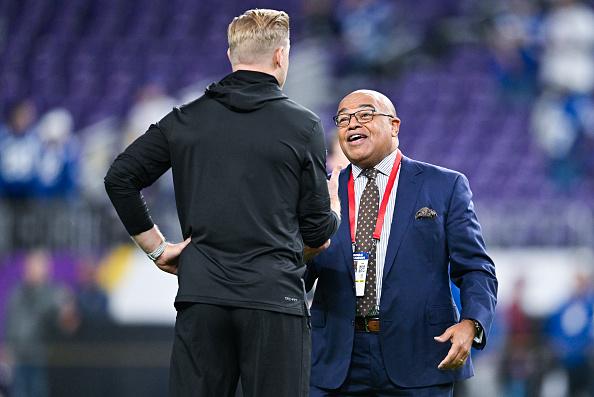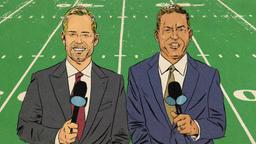This NFL season, I was present for the birth of a Mike Tirico Note. Specifics are important. On November 17, the Bengals played the Chargers on Sunday Night Football. The score was tied at 27 with 7:20 left in the fourth quarter. I was standing behind Tirico in the booth at SoFi Stadium, watching him like a stagehand studying an actor from the wings.
Tirico’s partner, Cris Collinsworth, was telling NBC viewers about one of the battles that could decide the game. The Chargers would try to run the ball. A Bengals defensive line full of injury substitutes would try not to get shoved backward.
As Collinsworth spoke, Tirico picked up an iPad. Some of Tirico’s busiest moments come when he isn’t talking but diving into impromptu research. As he listened to Collinsworth, Tirico had spotted a Bengals rookie defensive tackle named McKinnley Jackson on the field. Though Collinsworth didn’t mention Jackson, who hadn’t made a tackle all night, Tirico got the idea that he could use Jackson to illustrate his partner’s point. Like an NFL podcaster, Tirico began looking for a stat.
Tirico had 12 seconds to find it. When Collinsworth finished his point, Tirico told viewers, “McKinnley Jackson playing inside for Cincinnati. Averages about 16 snaps or so the last five games.” What happened next was good luck. Jackson sliced into the backfield to blow up a running play.
The top tier of NFL play-by-play announcers has gotten so good that it’s no longer useful to say so. What’s useful is to describe the different ways they narrate a game.
Joe Buck has such an unobtrusive way of calling Monday Night Football that it’s easy to forget he’s in total command. On Sundays, Tirico is an ecstatic dispenser of research, spotting developments on the field and trying to make them tangible with a fact or number. If viewers barely process the McKinnley Jackson note, Tirico’s approach creates a subconscious feeling that they haven’t missed a thing. I spent a week embedded with Tirico to see how he creates the effect.
A lot of Tirico calls, like Washington’s doinked game-winner last weekend, have lodged themselves in my brain. But I also find myself remembering the informational nuggets that adorn the calls. Two seasons ago, Tirico had the Rams-Bills season opener. When Buffalo kicker Tyler Bass lined up for a field goal, Tirico told viewers that Bass was kicking from his preferred hash mark, on the left.
Perhaps the best Tirico Note came during the 2023 Bengals-Ravens playoff game. With the game tied in the fourth quarter, Ravens quarterback Tyler Huntley tried to dive into the end zone and wound up fumbling the ball.
Tirico was able to tell viewers, with amazing speed, that Cincy defensive end Sam Hubbard had grabbed the ball and was running 98 yards the other way with it. The Tirico Note came mid-run, when he mentioned that Hubbard was a local product—“the Cincinnati kid!”
“I knew Mike was going to win the Emmy,” said Collinsworth. “And he didn’t. I’m like, ‘I don’t know what was on that other tape, but it must’ve been really good.’”
Tirico starts preparing to call a Sunday Night game on Monday morning. He watches a recording of the game he just called, looking for small things he could have done better. When we talked one Monday afternoon, Tirico had just called a Lions-Texans game in which Detroit coach Dan Campbell told an official he wanted to call a timeout with four seconds left on the game clock. The official thought Campbell wanted a timeout with four seconds left on the play clock.
Tirico hadn’t described that sideline mishap as efficiently as he wanted to. “If I would’ve been staring at the monitor and lip-reading at that moment,” he said, “I might have cut 10 seconds of the confusion out for the viewers.” (“Five seconds,” said Rob Hyland, Sunday Night’s coordinating producer.)
Tirico and Collinsworth have different responsibilities on Sunday nights. “I’m what,” said Tirico. “He’s why.” Meaning, Tirico narrates the path of the ball, and Collinsworth, with his telestrator and Hyland’s replays, explains how the ball got there.
Among play-by-play announcers, Tirico is unusually interested in the why part of the broadcast. When I caught up with him before a Cowboys-Bucs game in December, he was trying to illustrate running back Zeke Elliott’s struggles by figuring out how many of his carries had gone for 1, 2, or 3 yards.
Some of Sunday Night’s why is left entirely to Tirico. “I almost never talk about special teams,” said Collinsworth. “Because as soon as there’s a kick or a punt, we’re going to commercial.” Before a game, Tirico interviews kickers and punters and special teams coaches. You could hear the results during last weekend’s wild-card game. Tirico reported that Tampa Bay’s punter missed the preseason and dropped a snap the week before; after Washington’s winning field goal doinked its way home, Tirico noted that the upright has about the same width as a dollar bill.

Tirico spends about 60 hours preparing to call each Sunday Night game. Most of the information he collects goes in one of two places. His iPad is a repository for deep cuts: a Word document with notes from his interviews with coaches and players, participation data, further notes from researchers like Sunday Night stat man Ken Hirdt. If Tirico needs something on the iPad, he can find it in six or seven seconds.
Tirico puts more basic information—heights, weights, stats, alma maters—on his boards. For announcers, boards are what they sound like: poster boards they hold in their hands during the game. Announcers may not need to look at the boards if they’re talking about a star like Joe Burrow. But if an obscure player wanders into the frame, announcers will glance downward like churchgoers during the third or fourth verse of a hymn.
On Tirico’s board for the Chargers-Bengals game, he put this notation next to running back J.K. Dobbins:
(20)®805/9 TD (21)ACL + (22)8g (23)1g
In Tirico’s shorthand, that showed how Dobbins had gone from a good rookie year in 2020 to a bunch of lost seasons after his ACL injury. Below that, Tirico made this notation:
3-0 v MICH (211/4t-’19)
The fact that an Ohio State alum beat Jim Harbaugh three times in college is the beau ideal of a TV note. Tirico also included this:
24-112-0t 15
The first three numbers were Dobbins’s receiving stats. The last was the length of his longest catch. “So if he has an 18-yard reception,” said Tirico, “I don’t need somebody to tell me that’s his longest catch of the year.”
Announcers like to say things on TV before those of us watching at home can even think of them. Tirico’s quest for hyperefficiency started in 2006, when he called Monday Night Football with Tony Kornheiser and Joe Theismann. ESPN executives wanted to find more time for Kornheiser to talk between plays. Tirico said they even looked at transcripts of the broadcast to see how many words Kornheiser was squeezing in.
The executives asked Tirico: Do you have to tell viewers who made the tackle? To which Tirico replied: Well, the tackler is important sometimes. The upshot from the experience is that Tirico has found ways to be even more economical: telling viewers what the penalty will be before the referee announces it or calculating the yardage of a punt in his head before his spotter, Mike Black, calculates it for him. “I like to try to identify the receiver before or during the catch, not after he’s tackled,” said Tirico.
Tirico is helped by technology, as well. During COVID, Tirico’s announcing boards ceased to be physical objects. He transferred the boards to a 35-inch touchscreen monitor that sits at his left during games. Black, who sits one seat to the left of Tirico, has his own touchscreen monitor with the boards.
Usually, a spotter helps an announcer pick out who made a tackle by pointing to the player’s name on an announcer’s physical boards. Black can circle the name of, say, McKinnley Jackson on his monitor. Tirico sees that notation on his own monitor. The information comes out of his mouth quickly, shaving further microseconds off of the broadcast.
On Saturdays, Tirico huddles with Collinsworth and the Sunday Night crew in the city where the next night’s game is being played. Saturday is a day of meetings. I caught up with the crew at a waterside hotel in suburban Los Angeles, where they spent most of the day in a large conference room.
By then, Tirico had interviewed players, coaches, and the Chargers’ general manager. He’d looked over player participation data and watched some part of every game the two teams had played, either the whole game (two-plus hours without commercials), YouTube highlights (10 to 15 minutes), or NFL.com highlights (about five minutes). Now, a big part of his job was remembering what he’d learned.
“It doesn’t sound hard,” said Collinsworth. “People go, ‘What do you do? You’re working off of notes.’ You don’t have time to look at notes.”
A little after 9:30 a.m., Collinsworth showed the Sunday Night crew footage of the Chargers’ Justin Herbert playing against the Steelers in Week 3. “This is the game he came in with an ankle [injury] and it got worse,” said Tirico. “It got rolled up on at some point here. Going in this direction, too—left to right, somewhere around the 30 or so.”
Later, I watched the game in question. Herbert limped off the field after getting sacked on a play that started at the 34-yard line. On the CBS telecast, the Chargers were moving from left to right.
What Tirico doesn’t remember, he looks up. In the same meeting, the Sunday Night team watched footage of Scott Matlock, a defensive end Jim Harbaugh was also using as a fullback. (Bonus Tirico Note: John Harbaugh did the same thing in Baltimore with Patrick Ricard.)
When Matlock played offense, he took to tucking a towel into his pants, as if he were Keenan Allen in his prime. (Matlock caught four passes all year.) The Sunday Night crew thought that was funny. It was a John Madden kind of note! Tirico read aloud from his computer: “No towel can be longer than 6 by 8 inches. Just so you know.”
After the early film session, Tirico, Hyland, and an editorial producer named Jake Abrahams gathered for a story line meeting. If a note is a fact or number, a story line is the conversational grist of a game broadcast.
Tirico and Hyland had a pile of story lines for each team’s offense and defense. In the meeting, they ranked the story lines in order of importance. Take the Chargers defense. They decided the no. 1 story line was the defense’s statistical turnaround after the Brandon Staley Dark Times, a story that included x’s and o’s, Jim Harbaugh’s unique coaching methods, and the fearsome schedule that awaited the team. Coordinator Jesse Minter was the no. 2 story line. Joey Bosa, Khalil Mack, and the Chargers defensive ends were no. 3.
Occasionally, Tirico and Hyland would politely debate a story line’s importance. Safety Derwin James was a more urgent discussion topic than the Chargers’ fifth-round corners. But he wasn’t quite as urgent as Minter.
In my travels through the broadcasting world, I had never heard of story line power rankings. Or, at least, a weekly meeting devoted to them. This is part of Tirico and Hyland’s method. For each game, they try to establish a hierarchy of anecdotes. So if they dive into rabbit holes to find McKinnley Jackson’s snap count, they have a way-finder that will bring them back to the über-story of the game. “You get one swing at most of these stories,” said Tirico.
The Sunday Night team’s final meeting of the day took place at 5 p.m. Sunlight was no longer streaming through the windows, and the hotel conference room took on the darkened feel of an old-fashioned TV studio. By now, Tirico and Collinsworth knew most of what they were going to know about the Bengals and Chargers. They sat across the table from each other and began trying out the language they would use on TV.
Tirico asked Collinsworth a version of the question he would lob at him to open the game in the booth at SoFi Stadium: “What part of the Harbaugh experience has elevated this team?” Just as he would the next day on the air, Collinsworth let out a familiar chuckle and began to answer.
On Sunday, Tirico was in the booth at SoFi surrounded by his research. “This is a three-and-a-half-hour open-book test,” he said.
Within reach, Tirico had his digital boards and his iPad full of deep cuts. Tirico also had plastic folders in front of him that contained everything from the verbiage he uses at the start of the game to his handwritten score sheet. Next to the folders, Tirico had five Sharpies. These are for color-coded notes: green for the first quarter, orange for the second, and so forth. OfficeMax doesn’t have better customers than teachers and play-by-play announcers.
Tirico spends the hours before a game trying to take a final infusion of information. While he talks to his producer in the truck, he listens to RedZone on his AirPods. This way, he can sound like a fan who has watched a full day of football on the couch rather than an announcer who parachutes in to call a single game.
The day after the Bengals-Chargers game, Tirico tore his Achilles. That meant he had to sit rather than stand in the booth. Prior to his injury, when I studied him from the side of an LED video wall, Tirico didn’t look like he was auditioning for a tweetable announcer video. Occasionally, Tirico punched a word or phrase by moving his arm. Otherwise, he stood still and took sips of coffee from a mug. (Collinsworth drank Mountain Dew from a can.) The most interesting thing Tirico did was see the action on the field and try to answer the questions it suggested.
In the first quarter, Derwin James got called for a horse collar against running back Chase Brown. The replay showed that James grabbed Brown by the nameplate on his jersey rather than his collar. Without an assist from Collinsworth or house referee Terry McAulay, Tirico told viewers, “The nameplate counts for a horse collar.”
On the next drive, the Chargers’ Will Dissly caught a touchdown. “Known as a blocking tight end during his years in Seattle, he is having a year in the air!” said Tirico. That was true enough but lacked his preferred data point. So while Collinsworth handled the replay, Tirico pulled up Pro Football Reference on his iPad so he could tell the audience, just before the commercial, that Dissly had 14 career touchdowns.
What Tirico saw on the field led him to research errands. At the end of the first quarter, the Bengals called a timeout before trying to convert fourth-and-1. Tirico noticed an extra lineman, Matt Lee, had come out of the huddle on the wrong side. Then, again dipping into his iPad for player participation data, Tirico told viewers that Lee had played 11 snaps on offense all year.
Sometimes, Tirico can sound like a podcaster in no-note-left-behind mode. After Chargers cornerback Cam Hart gave up a catch in the second quarter, Tirico told viewers that Hart had once played wide receiver. That seems like the kind of note you save for a Cam Hart interception.
But knowing what Tirico knows about Hart creates a secondary effect with viewers. Which is that everything happening on the field feels seen and understood. There will be surprising plays, but the announcer will never be surprised by a question. I like to think that listening to an announcer call a football game is like riding in the passenger seat of a car, and that every top announcer drives differently. Mike Tirico could tell you the history of the freeway.
The metaphor isn’t completely out there. Before the game, I saw Tirico googling the Los Angeles Coliseum. Tirico said that Hyland had an image of the Coliseum he wanted to show going into a commercial. Another announcer—a good announcer—might narrate that beauty shot by saying, “Right down the road here in Los Angeles …”
Tirico was trying to find the precise distance between SoFi and the Coliseum. He told me: “You could say, ‘Oh, it’s about ...’ No. There’s an answer.”





